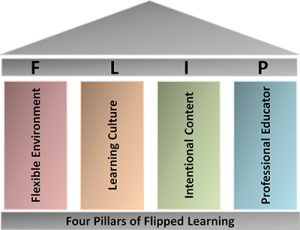What is Flipped Learning?
Posted by PLB Writer · Leave a Comment

 Flipped Learning is an approach that allows teachers to implement a specific methodology or various methodologies within their classrooms. The terms “flipped classroom” and “flipped learning” are not interchangeable. Flipping a class can, but does not necessarily, lead to Flipped Learning. Teachers may flip their classes by having students read text outside of class, watch supplemental videos or solve additional problems. But, to engage in Flipped Learning, teachers must incorporate the following four pillars into their practice.
Flipped Learning is an approach that allows teachers to implement a specific methodology or various methodologies within their classrooms. The terms “flipped classroom” and “flipped learning” are not interchangeable. Flipping a class can, but does not necessarily, lead to Flipped Learning. Teachers may flip their classes by having students read text outside of class, watch supplemental videos or solve additional problems. But, to engage in Flipped Learning, teachers must incorporate the following four pillars into their practice.
The four pillars of flipped learning
F: Flexible environment – Successful flipped learning requires flexible learning spaces, as well as the flexibility of how learning is delivered and assessed. Educators often physically rearrange their learning spaces to accommodate a lesson or unit to support either group work or independent study. They need to create flexible spaces in which students choose when and where they learn. Furthermore, educators who flip their classes are flexible in their expectations of student timelines for learning and in their assessments of student learning.
L: Learning Culture – The second pillar of flipped learning is a shift in the learning culture. It is a vital element of true flipped learning. When we consider the traditional teacher-centered model, the teacher is the primary source of information. Alternatively, the Flipped Learning model deliberately shifts instruction to a learner-centered approach. In this approach, in-class time is dedicated to exploring topics in greater depth and creating rich learning opportunities. As a result, students are actively involved in knowledge construction as they participate in and evaluate their learning in a manner that is meaningful to each individual.
I: Intentional Content – The third pillar of flipped learning is the intentional content. Well researched content is vital in the flipped classroom. With the shift to more learning outside of the classroom, the content moves from playing a “supporting” role to playing a central role. Educators use intentional content to maximize classroom time in order to adopt methods of student-centered, active learning strategies, peer instruction, problem-based learning, or mastery or Socratic methods depending on grade level and subject matter. They continually think about how they can use the Flipped Learning model to help students develop conceptual understanding, as well as procedural fluency. Teachers also determine what needs to be taught and what materials, students should explore on their own.
P: Professional Educator – The fourth pillar of flipped learning is the Professional Educator whose role in a Flipped Classroom, is even more important, and often more demanding, than in a traditional one. The educators constitute the essential ingredient that determines the success of flipped learning, even though they take on less visible roles within the classroom. During class time, they continually observe their students, providing them with feedback relevant at the moment, and assessing their work. Also, these professional educators are reflective in their practice, connect with each other to improve their instruction, accept constructive criticism and tolerate controlled chaos in their classrooms.



